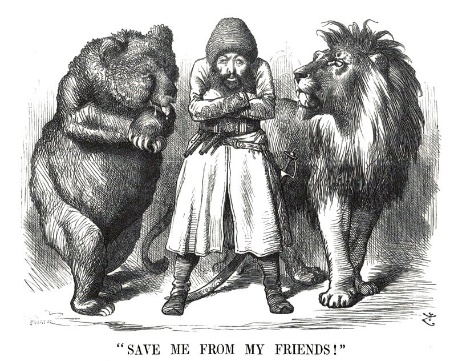38 CENTRAL ASIA
During the 19th century, Central Asia underwent profound transformations driven by regional powers and internal dynamics. The Russian Empire’s eastward expansion led to the conquest of the Kazakh Steppe and parts of modern-day Uzbekistan and Turkmenistan. This expansion began in the early 19th century, with Russia seeking to secure its southern borders and gain access to Central Asian trade routes. Meanwhile, the Emirate of Bukhara and Khanate of Khiva maintained independence, engaging in diplomatic and trade relations with Russia, Persia, and other neighbors.
In 1876, the Qing Empire expanded into Xinjiang, further altering the regional balance. This invasion was driven by the Qing dynasty’s desire to secure its western borders, control vital trade routes, and exploit the region’s natural resources, such as cotton, silk, and precious metals. The annexation of Xinjiang allowed China to consolidate its power and project influence into Central Asia. However, this expansion came at a significant cost to the native Uyghur, Kazakh, and Kyrgyz populations, who faced forced assimilation, cultural suppression, and economic exploitation. Chinese settlers were encouraged to migrate, leading to demographic changes and tensions. Local leaders were co-opted or replaced with Chinese officials, and Islamic practices were restricted, sparking periodic uprisings and rebellions.
Local leaders like Yaqub Beg (1820-1877, Kashgar) and the Muqaddasi rebels (1870s-1880s, Samarkand and Bukhara) resisted Russian and Qing dominance, illustrating Central Asia’s resilience. Ancient trade networks, including the Silk Road, continued to facilitate cultural exchange and economic ties between Central Asia, China, India, and the Middle East. As external powers extended their reach, introducing administrative practices and infrastructure, indigenous traditions persisted
Throughout the 19th century, Afghanistan remained a crucial focal point in Central Asia for Russian interests. The Pashtun tribes, functioning as feudal lords, held sway over the region, occupying key government and administrative positions. In 1826, Dost Mohammad Khan of the Barakzai Dynasty seized power, marking the end of the Durrani Dynasty’s rule. This shift sparked tensions as the British sought to utilize Afghanistan as a strategic buffer zone between Russian expansion and their Indian territories.
The British aimed to contain Russian influence and protect their Indian holdings through this geopolitical maneuver. However, it led to a series of conflicts, notably the Afghan Wars, where Indian soldiers fought alongside British officers against Afghan forces, occasionally backed by Russia. In the First Afghan War (1838-1842), British forces captured Kabul and other major cities, but they faced unyielding resistance from the Afghan people, who ultimately expelled the British-Indian troops. The British returned during the Second Afghan War (1878-1879), installing Abdul Rahman Khan as a pro-British emir. This move reflected British efforts to exert influence in Afghanistan while countering Russian expansion in the region.

A 1878 political cartoon showing the Emir of Afghanistan surrounded by his “friends.” The bear represents Russia, and the lion stands for Great Britain. (Source: Wikimedia)
Under British imperialism, Afghans faced significant social, economic, and political upheaval. The British imposed their own administrative systems, displacing traditional Afghan institutions and undermining local authority. Afghans were subject to harsh taxation, forced labor, and restrictive laws that curtailed their freedom. The British exploited Afghanistan’s natural resources, including its lucrative caravan trade, and imposed economic policies that benefited British India at the expense of Afghan merchants. Afghans were also exposed to cultural imperialism, as British-style education and Western values were promoted, often at the expense of traditional Islamic practices. Furthermore, the British fostered divisions among Afghan tribes, using tactics like divide-and-rule to maintain control. Many Afghans were forcibly displaced, and their lands were confiscated to make way for British-backed infrastructure projects, such as roads and telegraph lines. The overall effect was widespread poverty, displacement, and resentment among Afghans, fueling anti-British sentiment and eventual resistance.
To the north of Afghanistan, the region of East Turkistan was under Chinese control until 1865, when Russian forces invaded the Khanate of Kokand, capturing Tashkent. This marked the beginning of Russia’s expansion into Central Asia. Khiva, an independent khanate on the east shore of the Caspian Sea, fell to Russia in 1873. Kokand, located northeast of Khiva, resisted Russian rule until 1876, when it too was absorbed into the Russian Empire. The Kazakh and Kirghiz territories had already been under Russian control since 1854. As a result, the entire region was enveloped in the “Great Game” of imperial rivalry between Russia and Britain.
In 19th-century Tibet, the social hierarchy was rigidly defined, reflecting the region’s unique cultural and historical contextual connections to Central Asia. The majority of the population lived as serfs, bound to estates by birth, while a small percentage worked as tenant farmers. Nobles, monasteries, and the government owned approximately 95% of the land. Nomadic cultures thrived in outlying areas, distinct from settled agricultural communities.
During this period, Tibetan Buddhism profoundly influenced society, shaping cultural practices and social norms. Monasteries served not only as religious centers but also played a significant role in governance and education under the rule of the Dalai Lama. Lamas (monks) held considerable power and influence. Social mobility was limited, but joining a monastery offered a rare path to education and advancement. However, this system also perpetuated inequality, reinforcing the power of the nobility and clergy.
